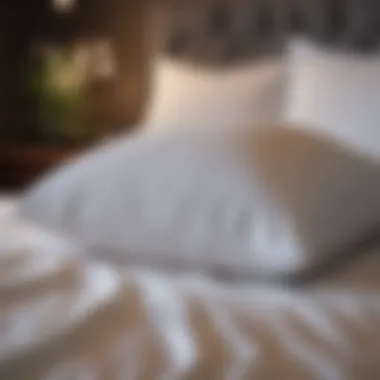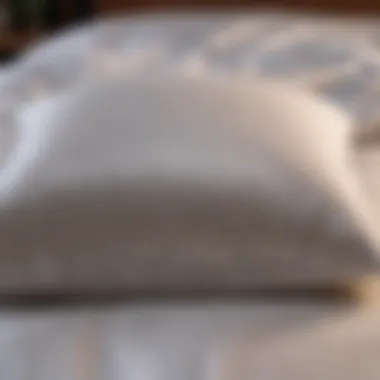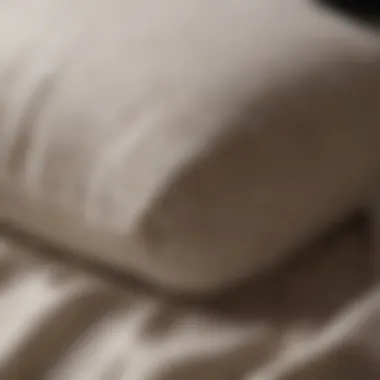Best Pillow Sheets for Acne Prevention


Intro
The choice of pillow sheets can have subtle yet significant effects on acne-prone skin. Understanding the materials and their properties is essential for individuals seeking healthier skin. The link between bedding and skin health often goes unnoticed, despite its importance.
In this guide, we explore various aspects of pillow sheets, focusing on the best fabrics that can help in preventing acne. We will examine how the right cleaning techniques can make a difference and offer practical tips for selecting pillow sheets tailored to specific skin needs. The aim is to provide clear insights that empower readers to make informed decisions about their bedding, ultimately assisting in acne management and encouraging better skin health.
Material Matters
Fabrics to Consider
When choosing pillow sheets for acne prevention, the fabric is crucial. Certain materials are better suited for sensitive skin. Cotton, for example, is breathable and hypoallergenic.
Key Fabrics:
- Cotton: Offers moisture-wicking properties. It allows the skin to breathe and reduces the chance of irritation.
- Bamboo: Naturally antibacterial and hypoallergenic. This fabric is also soft, making it gentle on the skin.
- Silk: Known for its smooth surface, it reduces friction, which can prevent skin irritation.
Fabrics to Avoid
While some fabrics are beneficial, others can complicate existing skin conditions. Fabrics that trap heat or moisture can exacerbate acne.
Fabrics to Avoid:
- Polyester: Tends to trap moisture and heat, which can lead to increased breakouts.
- Satin: Can cause increased friction on the skin, leading to irritation.
Cleaning Techniques
The maintenance of pillow sheets is as vital as the fabric choice. Regular cleaning is essential for reducing bacteria and oils that can lead to acne.
- Washing Frequency: It is generally advisable to wash pillow sheets at least once a week.
- Temperature: Use hot water to effectively kill bacteria and allergens.
- Detergents: Choose detergents that are free from harsh chemicals and fragrances.
Proper maintenance of your pillow sheets can significantly impact your skin health. Regular washing removes oils and bacteria that build up and can lead to breakouts.
Choosing the Right Pillow Sheets
Selecting the right pillow sheets for acne involves more than just choosing the right materials. Here are some practical tips to consider:
- Skin Type: Consider individual skin sensitivity when selecting materials.
- Thread Count: A higher thread count can indicate a softer, more durable fabric, but balance is key; overly high thread counts can trap heat.
- Certification Labels: Look for labels that indicate organic or hypoallergenic materials.
Understanding the Link Between Pillow Sheets and Acne
The relationship between pillow sheets and acne may not be immediately apparent to everyone, yet it plays a critical role in skin health. Pillow sheets can impact how your skin reacts overnight. More so, understanding this connection is vital for anyone prone to acne. Factors such as fabric type, cleanliness, and skin sensitivity should all be considered in this context. Choosing the right pillow sheets can promote clearer skin and support better skin care routines.
The Role of Sleep in Skin Health
Sleep is more than just a time for rest; it is essential for body recovery, including skin recovery. During deep sleep, the skin undergoes various repairing processes. Hormones that promote cell regeneration and repair are released. Therefore, achieving quality sleep is important not just for energy but also to maintain healthy skin.
Inadequate or disrupted sleep can exacerbate skin issues, including acne. It can increase stress hormone levels, which may lead to inflammation and oil production, potentially triggering breakouts. Good sleep hygiene, combined with skin-friendly pillow sheets, can further enhance your overall skin condition. Hence, prioritizing restorative sleep in conjunction with the right materials can yield better results for those looking to manage acne.
How Pillow Sheets Influence Acne Development
Pillow sheets play a significant role in either aggravating or alleviating acne issues. Fabrics can affect how your skin interacts with the surface it comes into contact with throughout the night. For example, rough materials may irritate the skin, leading to inflammation and breakouts. In contrast, softer and smoother fabrics can minimize friction and reduce skin irritation.
Furthermore, hygiene is essential. Dirty pillow sheets can harbor bacteria, dirt, and oils that contribute to skin problems. People with acne-prone skin should choose materials that can be easily washed and changed regularly. Keeping pillow sheets clean ensures that harmful agents do not sit against the skin overnight. This proactive approach can help maintain a healthier skin barrier, encouraging acne-free skin—
"The cleanliness of your pillow sheets is just as critical as the fabric you choose."
Overall, the interplay between sleep, pillow materials, and upkeep is integral to managing acne. Recognizing this link can inform more deliberate choices in bedding and skin care.


Materials to Consider for Pillow Sheets
When it comes to selecting pillow sheets that cater to acne-prone skin, understanding the materials used is crucial. These materials can have a significant impact on how well your skin breathes, absorbs moisture, and interacts with acne-causing bacteria. It is essential to consider how fabric choices can affect not only your overall comfort but also the health of your skin. To aid in this decision-making process, we will discuss four popular fabric types: cotton, silk, bamboo, and microfiber. Each fabric has distinct benefits and considerations to help you decide which options best suit your needs.
Cotton: The Classic Choice
Cotton remains one of the most popular choices for pillows sheets. It is known for its breathable qualities, making it suitable for a variety of climates. Cotton absorbs moisture while still allowing air to circulate, which is important for skin health. The natural fibers also make it less likely for bacteria to thrive, reducing the chance of acne breakouts.
Additionally, cotton is easy to care for, as it can withstand frequent washing. Regular cleaning is essential to remove oils and dirt that can accumulate, potentially leading to skin irritations. It is advisable to choose high-quality cotton products, such as Egyptian or Supima cotton, as these tend to be softer and more durable.
Silk and Satin: Luxe Options for Skin
Silk and satin pillow sheets offer a luxurious option that comes with additional benefits for those concerned about their skin. These materials are hypoallergenic, preventing irritation and allergic reactions often caused by dust mites and other allergens. Their smooth surface also reduces friction against the skin, which can minimize sleep creases and the potential for acne aggravation.
While these options tend to be more expensive than cotton, they are worth considering for anyone with sensitive skin. It is important to note that silk sheets require gentle cleaning methods to maintain their integrity. Hand-washing or using a delicate wash cycle is recommended, along with avoiding harsh detergents that could damage the fabric.
Bamboo: An Eco-Friendly Alternative
Bamboo sheets are gaining popularity for their environmental benefits and skin-friendly features. This fabric is derived from the bamboo plant, making it a great option for eco-conscious consumers. Bamboo is naturally antibacterial, which helps to fight acne-causing bacteria on contact. Additionally, bamboo sheets excel at moisture-wicking, keeping the skin dry throughout the night.
Moreover, bamboo fibers are soft and breathable, making for a comfortable sleeping experience. Just like cotton, these sheets can be machine washed, although it is advised to use cold water to preserve their qualities over time. The combination of sustainability and skin-friendly characteristics makes bamboo a suitable choice for individuals aiming to reduce their ecological footprint while also caring for their skin.
Microfiber: Budget-Friendly but Effective
Microfiber is a synthetic material that offers affordability without compromising quality. While it may not be as breathable as cotton or bamboo, microfiber has its advantages. The tight weave of microfiber helps repel allergens and dust mites, which can be beneficial for those with sensitive skin.
Additionally, microfiber is easy to maintain and can be washed with minimal hassle. It dries quickly, reducing the risk of mold and mildew growth. The downside is that it may trap heat more than natural fiber options, so those who sleep hot might prefer to look for more breathable fabric alternatives. Overall, microfiber remains a practical choice for those on a budget who are looking for adequate protection against skin issues.
Conclusion: In summary, the materials used in pillow sheets play a vital role in maintaining skin health. Whether you favor the classic comfort of cotton, the luxurious feel of silk, the eco-friendliness of bamboo, or the practicality of microfiber, there are options available that cater to various skin needs. Selecting the right material is a decisive step toward achieving clearer skin and a better sleep experience.
Hypoallergenic Options for Sensitive Skin
In the pursuit of healthy skin, individuals prone to acne must consider the role of their bedding. This section explores hypoallergenic options for pillow sheets, elaborating on the significance of carefully selected fabrics. Choosing hypoallergenic materials can significantly mitigate skin irritations, especially for those with sensitive skin. Such fabrics help create a conducive environment for skin health during sleep.
The Importance of Hypoallergenic Fabrics
Hypoallergenic fabrics are designed to reduce the chance of irritations or allergic reactions. Many traditional fabrics can harbor dust mites, mold, and other allergens that exacerbate skin conditions. For individuals battling acne, this can complicate an already delicate situation.
Using hypoallergenic pillow sheets can:
- Minimize Allergens: These fabrics often resist common allergens, ensuring a cleaner sleep environment.
- Enhance Comfort: Hypoallergenic materials are often softer and more breathable. This can prevent overheating which is crucial in maintaining overall skin health.
- Reduce Skin Irritation: By minimizing the chances of an allergic reaction, these sheets can help prevent additional breakouts linked to inflammation and rashes.
In essence, selecting hypoallergenic pillow sheets can be a proactive choice in a multi-faceted skincare regimen. It is not merely about the aesthetics of bedding but about fostering an environment that prioritizes skin well-being.
Best Hypoallergenic Pillow Sheets
When it comes to choosing the best hypoallergenic pillow sheets, various materials stand out. Each option comes with its unique advantages:
- Organic Cotton: Known for its natural properties, organic cotton is inherently hypoallergenic. It is free from harmful chemicals and treated fabrics that could irritate sensitive skin.
- Bamboo Fabric: Bamboo sheets are popular for their soft feel and breathable nature. They naturally repel allergens and are suitable for sensitive skin types.
- Tencel: Made from sustainably sourced wood pulp, Tencel is known for its excellent moisture-wicking properties. This characteristic helps minimize bacterial growth, making it a smart choice for those with acne-prone skin.
- Silk: While it may come with a higher price tag, silk sheets can offer significant benefits. They help retain moisture and can prevent skin from drying out overnight, reducing the likelihood of irritation.
Incorporating these hypoallergenic options into your bedding can support better skin health, especially for those battling acne or sensitivity. Each material provides unique benefits aligned with the goal of peaceful and restorative sleep.
Cleaning Practices for Pillow Sheets
Maintaining the cleanliness of pillow sheets is vital for skin health, especially for individuals prone to acne. Over time, pillow sheets accumulate oil, sweat, and bacteria. These contaminants can be harmful and may trigger acne flare-ups. Therefore, adopting effective cleaning practices is essential to ensure that your bedding does not contribute to skin problems.
Frequency of Washing Pillow Sheets
It is recommend washing pillow sheets at least once a week. Regular cleaning helps to remove dirt and oils. Doing so can prevent the build-up of acne-causing bacteria. In warmer climates or during the summer, increasing this frequency becomes necessary. A more frequent wash schedule can help reduce allergen accumulation as well. Consider your daily routine and personal hygiene to properly assess how often you should wash your sheets.


Selecting the Right Detergent
Choosing a gentle, hypoallergenic detergent is important for maintaining the integrity of your pillow sheets. Opt for a detergent free from fragrances and dyes. These additives may cause irritation for sensitive skin. Brands such as Seventh Generation and Mrs. Meyer's Clean Day offer various hypoallergenic options. Always read labels to check for chemical ingredients that could affect your skin. A quality detergent not only cleans effectively but also protects the fabric.
Tips for Effective Stain Removal
Stains are inevitable, as pillow sheets can get soiled from hair products, sweat, and oils. To remove stains effectively, treat them as soon as possible. Here are some methods to consider:
- Pre-Treat Stains: Use a mixture of baking soda and water to form a paste and apply it to the stained area before washing.
- Cold Water Rinse: Always rinse your pillows in cold water as hot water can set the stains further.
- Avoid Bleach: Rather than bleach, consider using a natural option like lemon juice mixed with water for whitening effects.
By applying these cleaning practices, you can maintain your pillow sheets and protect your skin's health. Keep in mind that a clean sleeping environment significantly impacts acne management.
Best Pillow Sheets for Acne-Prone Skin
Selecting the right pillow sheets is crucial for individuals who struggle with acne. Skin prone to breakouts requires thoughtful care, extending beyond skincare products to include what you sleep on. The fabric of your pillow sheets can directly influence the condition of your skin by either contributing to or alleviating the problem. Additionally, factors such as breathability, moisture-wicking properties, and the presence of allergens in the fabric must be considered. This section aims to delve into various types of pillow sheets and their specific attributes, offering a comprehensive look at how they interact with acne-prone skin.
Top Cotton Pillow Sheets Reviewed
Cotton remains a preferred fabric for many. Its popularity stems from its breathability and softness. Cotton pillow sheets allow air circulation, which helps in keeping the skin cool. Moreover, cotton is absorbent, which means it can wick away moisture from perspiration. However, not all cotton is created equal. Here are some qualities to consider:
- Thread count: Higher thread counts usually mean softer and more durable sheets.
- Organic cotton: This type is free from harmful chemicals, thus reducing the risk of skin irritation.
Some recommended options include:
- Boll & Branch Signature Hemmed Sheet Set: Known for its softness and durability.
- Pottery Barn Organic Cotton Sheet Set: Provides comfort while being chemical-free.
Silk Pillow Sheets: Myths and Facts
Silk pillow sheets are often promoted as a luxury item that benefits the skin. Many believe they prevent acne due to their smooth texture and hypoallergenic properties. For those debating their effectiveness, consider these facts:
- Hypoallergenic: Silk tends to resist dust mites and allergens, making it a safe choice for sensitive skin.
- Moisture retention: Unlike other materials, silk can help retain skin moisture, potentially reducing dryness that might lead to breakouts.
However, some myths persist. Silk needs to be cleaned regularly, as oils from your skin can build up, causing issues if neglected. Recommended brands include:
- Lunya Washable Silk Pillowcase: Easy to clean and retains its luxury feel.
- Slip Pure Silk Pillow Case: Offers a breathable option that maintains skin hydration.
Bamboo Pillow Sheets: A Review
Bamboo fabric is gaining traction for its eco-friendliness and skin benefits. Bamboo sheets are naturally moisture-wicking, helping to keep the skin dry and less prone to breakouts. Additionally, they have inherent antibacterial properties. These qualities make bamboo a compelling choice for those with acne-prone skin.
Some characteristics to note:
- Softness: Bamboo sheets are often softer than cotton, appealing to many users.
- Breathability: They allow ample airflow, reducing sweat accumulation overnight.
Examples of bamboo pillow sheets include:
- Eucalyptus Silk Bamboo Sheet Set: Eco-friendly and luxurious.
- Cariloha Bamboo Sheets: Known for their softness and sustainability.
Microfiber Pillow Sheets: Wallet-Friendly Picks
Microfiber may not be the first choice for acne-prone individuals, but it does have several advantages. These pillow sheets are budget-friendly while providing sufficient moisture-wicking capabilities. Microfiber material can help keep excess oil off the skin, which is vital for preventing acne.
Points to keep in mind include:
- Durability: Microfiber is typically long-lasting, making it a reasonable investment.
- Stain resistance: Many microfiber options resist stains better than natural fibers.
Consider brands like:


- AmazonBasics Microfiber Sheet Set: A cost-effective solution.
- Utopia Bedding Microfiber Sheets: Offers good quality at an affordable price.
Pillow Maintenance Tips for Acne Prevention
Maintaining clean and suitable bedding is critical for those prone to acne. The right pillow situations can not only provide comfort but also reduce skin irritations. Regular maintenance goes beyond aesthetic appeal; it directly influences skin health on a molecular level. Here, we explore key practices to help in managing acne through better pillow maintenance.
The Role of Pillow Protectors
Pillow protectors act as a barrier between your skin and the pillow itself. These thin layers are designed to keep the pillow clean and safeguard it from sweat, oils, and other contaminants that accumulate over time. Opting for hypoallergenic pillow protectors can reduce your exposure to dust mites and allergens, providing an additional layer of defense against acne development.
- Choose protectors made from breathable materials to facilitate airflow, which prevents heat buildup.
- Wash them regularly to eliminate any bacteria or allergens that might contribute to skin irritations.
- Look for options that are specifically designed to repel moisture and minimizes the chances of breeding harmful microbes.
Benefits of Using Pillow Protectors:
- They extend the lifespan of your pillows.
- Simplified cleaning routines.
- Enhanced comfort while sleeping.
Proper use of pillow protectors can significantly aid in acne management by ensuring a cleaner sleep environment and reducing triggers that aggravate breakouts.
How to Choose the Right Pillow for Your Skin
Selecting the right pillow is as important as maintaining your bedding. Many people overlook how their pillow can impact their skin. Here are some considerations for choosing an acne-friendly pillow:
- Material Matters: Pillows infused with certain materials can affect sweat absorption and heat retention. For example, memory foam tends to retain heat, while cotton offers breathability.
- Hypoallergenic Options: Opt for pillows labeled hypoallergenic to diminish allergic reactions, which could potentially worsen acne. Materials like latex or gel often offer such properties.
- Pillow Firmness: A firm pillow ensures your head stays aligned, minimizing pressure on your skin, which could lead to breakouts. Consider how your sleeping position (stomach, back, or side) can influence your choice.
Keep in mind that a personalized approach often yields the best results. Take time to assess your own skin's response to different fabrics and pillow types. Ultimately, it is crucial to find a balance between comfort and skin health for optimal acne prevention.
Beyond Pillow Sheets: Holistic Approaches to Acne Management
A comprehensive understanding of acne management requires looking not only at pillow sheets but also at overall habits that influence skin health. The discussion of pillow materials and their cleanliness is vital, yet it forms only part of the larger picture. Individual skincare routines and dietary choices play substantial roles in managing acne and improving skin conditions. Recognizing how these elements interact to either exacerbate or alleviate acne symptoms can empower individuals to make more informed choices.
Skincare Routines that Complement Pillow Choices
Developing an effective skincare routine is fundamental in supporting the benefits of quality pillow sheets. A regimen tailored to individual skin type and specific needs can greatly enhance the overall health of the skin. Proper cleansing is the first step; it is essential to remove accumulated dirt, oils, and impurities that can clog pores and lead to breakouts.
- Cleansers: Choosing a gentle cleanser formulated for acne-prone skin helps to maintain the skin's pH balance without stripping it of essential moisture.
- Exfoliation: Regular exfoliation, an often-overlooked step, can assist in removing dead skin cells and preventing blockages in pores. Options can include chemical exfoliants with AHA or BHA and physical scrubs that are not too abrasive.
- Moisturizer: Even oily skin needs hydration. Select a non-comedogenic moisturizer to ensure pores remain clear while providing essential moisture.
- Spot Treatment: Applying targeted treatments containing benzoyl peroxide or salicylic acid can reduce outbreaks and prevent future blemishes.
By aligning your routine with the choice of pillow sheets, you create a synergistic effect. For instance, using silk pillow sheets alongside a gentle cleanser may support skin’s health better by minimizing friction and moisture wicking, which often aggravates acne.
The Impact of Diet on Skin Health
Diet is another critical factor that impacts skin health. The foods we consume can directly influence inflammation levels, hormonal responses, and overall skin condition. For those suffering from acne, certain dietary changes may prove beneficial.
- Whole Foods: Focusing on whole foods, particularly fruits and vegetables, can provide vital vitamins and antioxidants that support skin resilience.
- Omega-3 Fatty Acids: Incorporating sources of Omega-3, found in foods like salmon and walnuts, can reduce inflammation and help maintain skin barrier function.
- Limit Sugar: High sugar intake has been linked to increased acne flare-ups. Reducing sugary snacks and beverages could lead to clearer skin over time.
- Stay Hydrated: Proper hydration supports skin elasticity and flushes out toxins, contributing to a clearer complexion.
A balanced diet is equally important as selecting the right pillow sheets. One complements the other, creating a holistic approach to acne management.
Epilogue: Making Informed Choices for Better Skin Health
The significance of choosing the right pillow sheets cannot be overstated, especially for those who suffer from acne-prone skin. This article has highlighted how specific materials can influence skin health. Now it is crucial to synthesize this knowledge. Understanding the relationship between pillow sheets and acne allows individuals to make informed decisions that can potentially reduce breakouts and enhance skin appearance.
Several factors come into play when selecting the best pillow sheets. The fabric choice, for instance, can greatly affect skin moisture levels and bacteria buildup. Moreover, regular cleaning practices also contribute to maintaining a healthy sleeping environment. By being educated about these aspects, readers can take proactive steps in their skincare journeys.
In considering these elements, it is essential to recognize the ongoing nature of skincare. The choices made today, such as investing in quality pillow sheets, can have lasting impacts on skin health. Keeping abreast of developments in fabric technology and skincare can further empower consumers to adapt their practices over time. Ultimately, informed choices represent a commitment to skin health and overall well-being.
Recap of Key Insights
- Material Matters: The fabric of pillow sheets plays a role in managing acne. Choices like silk or cotton can offer benefits over synthetics.
- Cleaning Frequency: Regular washing of pillow sheets is vital. It minimizes bacteria and dirt that could contribute to breakouts.
- Hypoallergenic Fabrics: For sensitive skin, hypoallergenic sheets are beneficial. They help reduce irritation and inflammation.
- Pillow Maintenance: Using pillow protectors and clean pillows plays a significant role in preventing acne.
- Holistic Approaches: Overall skin health goes beyond bedding. Diet and skincare routines complement the choice of pillow sheets.
Through these insights, it becomes clear that thoughtful choices can cultivate better skin health. Readers are encouraged to consider their specific needs and preferences for an optimal experience.
Final Recommendations for Pillow Sheets
- Choose Natural Fabrics: Opt for cotton or silk for breathability and comfort.
- Consider Bamboo Options: Bamboo offers a sustainable choice while being gentle on the skin.
- Stick to Hypoallergenic Choices: If you have sensitive skin, prioritize hypoallergenic materials to prevent allergic reactions.
- Regular Cleaning: Wash your pillow sheets at least once a week. Use an unscented detergent to avoid irritation.
- Invest in Quality: A higher initial investment in materials may lead to better long-term skin health.
By keeping these recommendations in mind, readers can navigate the myriad of pillow sheets available and make selections that protect and enhance their skin's health.















